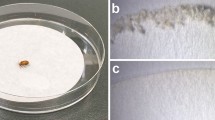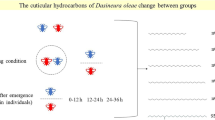Abstract
Cuticular lipid components were examined from fourth-instar larvae ofManduca sexta reared on artificial diet or growing plants. The plants used were potato, tobacco, and tomato grown in pots in a greenhouse. Twenty-eight components made up the bulk of the lipids, but there were significant differences in the proportions of them present in insects reared on the different diets. In the case of some insect cuticular lipid components, there was an obvious relationship with the surface components of the plant, but generally this relationship was weak. Nonetheless, the differences may have ecological relevance, as indicated by preliminary work on predation.
Similar content being viewed by others
References
Baker, J.E., Sukkestad, D.R., Woo, S.M., andNelson, D.R. 1978. Cuticular hydrocarbons ofTribolium castaneum: effects of the food additive tricalcium phosphate.Insect Biochem. 8:159–167.
Bernays, E.A., Blaney, W.M., andChapman, R.F. 1975. The problems of perception of leaf-surface chemicals by locust contact chemoreceptors, pp. 227–230,in D.A. Denton and J.P. Coghlan (eds.). Olfaction and Taste, Vol. V. Academic Press, New York.
Bernays, E.A., Blaney, W.M., Chapman, R.F. andCook, A.G. 1976. The ability ofLocusta migratoria L. to perceive plant surface waxes, pp. 35–40,in T. Jermy (ed.). The Host-Plant in Relation to Insect Behavior and Reproduction, Vol. 16. Plenum Press, New York.
Blomquist, G.J., andJackson, L.L. 1973. Incorporation of labelled dietaryn-alkanes into cuticular lipids of the grasshopperMelanoplus sanguinipes.J. Insect Physiol. 19:1639–1647.
Blomquist, G.J., andDillwith, J.W. 1985. Cuticular lipids, pp. 117–154,in G.A. Kerkut and L.I. Gilbert (eds.) Comprehensive Insect Physiology, Biochemistry and Pharmacology, Vol. 3. Integument, Respiration and Circulation. Pergamon, Oxford, U.K.
Blomquist, G.J., Soliday, C.L., Byers, B.A., Brakke, J.W., andJackson, L.L. 1972. Cuticular lipids of insects. V. Cuticular wax esters of secondary alcohols from the grasshoppersMelanoplus packardii andMelanoplus sanguinipes.Lipids 7:356–362.
Blomquist, G.J., Blailock, T.T., Scheetz, R.W., andJackson, L.L. 1976. Cuticular lipids of insects. VII. Cuticular hydrocarbons of the cricketsAcheta domesticus, Gryllus pennsylvanicus and Nemobius fasciatus.Comp. Biochem. Physiol. 54B:381–386.
Blomquist, G.J., Nelson, D.R., andDe Renobales, M. 1987. Chemistry, biochemistry, and physiology of insect articular lipids.Arch. Insect Biochem. Physiol. 6:227–265.
Bordner, J., Danehower, D.A., Thacker, J.D., Kennedy, G.G., Stinner, R.E., andWilson, K.G. 1983. Chemical basis for host plant selection, pp. 245–264,in P.A. Hedin (ed.). Plant Resistance to Insects. ACS Symposium, Las Vegas. American Chemical Society, Washington, D.C.
Bowers, W.S., andThompson, M.J. 1965. Identification of the major constituents of the crystal-line powder covering the larval cuticle ofSamia cynthia ricini (Jones).J. Insect Physiol. 11:1003–1011.
Brown, J.J. 1987. Toxicity of herbicides thiobencarb and endothall when fed to laboratory-rearedTrichoplusia ni (Lepidoptera: Noctuidae).Pestic. Kochern. Physiol. 27:97–100.
Buckner, J.S., Nelson, D.R., Hakk, H., andPomonis, J.G. 1984. Long chain oxoaldehydes and oxoalcohols from esters as major constituents of the surface lipids ofManduca sexta pupae in diapause.J. Biol. Chem. 259:8452–8460.
Bursell, E., andClements, A.N. 1967. The cuticular lipids of the larva ofTenebrio molitor L. (Coleoptera).J. Insect Physiol. 13:1671–1678.
Cassagne, C., andLessire, R. 1975. Studies on alkane biosynthesis in epidermis ofAlliumporrum L. leaves. IV. Wax movement into and out of the epidermal cells.Plant Sei. Lett. 5:261–268.
Chang, S.Y., andGrunwald, C. 1980. Structural organization of tobacco leaf polar cuticular lipids.Bot. Gaz. 141:360–365.
Chapman, R.F. 1977. The role of the leaf surface in food selection by acridids and other insects.Colloq. Int. C.N.R.S. 265:133–149.
Cutler, H.G., Severson, R.F., Cole, P.D., Jackson, D.M., andJohnson, A.W. 1986. Secondary metabolites from higher plants. Their possible role as biological control agents, pp. 178–196,in M.B. Green and P.A. Hedin (eds.). Natural Resistance of Plants to Pests: Roles of Allelochemicals. American Chemical Society, Washington, D.C.
Danehower, D.A., andBordner, J. 1984. Cuticular wax ofEpilachna varivestis.Insect Biochem. 14:671–676.
Espelie, K.E., Köller, W., andKolattukudy, P.E. 1983. 9,16-Dihydroxy-10-oxo-hexadecanoic acid, a novel component inCitrus cutin.Chem. Phys. Lipids 32:13–26.
Hendry, L.B., Wichmann, J.K., Hindenlang, D.M., Weaver, K.M., andKorzeniowski, S.H. 1976. Plants—the origins of kairomones utilized by parasitoids of phytophagous insects?J. Chem. Ecol. 2:271–283.
Holloway, P.J., Jeffree, C.E., andBaker, E.A. 1976. Structural determination of secondary alcohols from plant epicuticular waxes.Phytochemistry 15:1768–1770.
Jackson, L.L., Armold, M.T., andRegnier, F.E. 1974. Cuticular lipids of adult fleshflies,Sarcophaga bullata.Insect Biochem. 16:433–439.
Jeffree, C.E., Baker, E.A., andHolloway, P.J. 1975. Ultrastructure and recrystallization of plant epicuticular waxes.New Phytol. 75:539–549.
Jones, C.G., Young, A.M., Jones, T.H., andBlum, M.S. 1982. Chemistry and possible roles of cuticular alcohols of the larval Atlas moth.Comp. Biochem. Physiol. 73B:797–801.
Lockey, K.H. 1988. Lipids of the insect cuticle: origin, composition and function.Comp. Biochem. Physiol. 89B:595–645.
Maloney, P.J., Albert, P.J., andTulloch, A.P. 1988. Influence of epicuticular waxes from white spruce and balsam fir on feeding behavior of the eastern spruce budworm.J. Insect Behav. 1:197–208.
Nelson, D.R. 1978. Long-chain methyl-branched hydrocarbons: Occurrence, biosynthesis and function.Adv. Insect Physiol. 13:1–33.
Nelson, D.R., andSukkestad, D.R. 1970. Normal and branched aliphatic hydrocarbons from the eggs of the tobacco hornworm.Biochemistry 9:4601–4611.
Nelson, D.R., Sukkestad, D.R., andTerranova, A.C. 1971. Hydrocarbon composition of the integument, fat body, hemolymph and diet of the tobacco hornworm.Life Sei. 10:411–419.
Nelson, D.R., Sukkestad, D.R., andZaylskie, R.G. 1972. Mass spectra of methyl-branched hydrocarbons from eggs of the tobacco hornworm.J. Lipid. Res. 13:413–421.
Percy, J.E., Blomquist, G.J., andMacDonald, J.A. 1983. The wax-secreting glands ofEriocampa ovata L. (Hymenoptera: Tenthredinidae): Ultrastructural observations and chemical composition of the wax.Can. J. Zool. 61:1797–1804.
Richter, I., andKrain, H. 1980. Cuticular lipid constituents of cabbage seedpod weevils and host plant oviposition sites as potential pheromones.Lipids 15:580–586.
Severson, R.F., Arrendale, R.F., Chortyk, O.T., Johnson, A.W., Jackson, D.M., Gwynn, G.R., Chaplin, J.F., andStephenson, M.G. 1984. Quantitation of the major cuticular components from green leaf of different tobacco types.J. Agric. Food Chem. 32:566–570.
Soliday, C.L., Blomquist, G.J., andJackson, L.L. 1974. Cuticular lipids of insects. VI. Cuticular lipids of the grasshoppersMelanoplus sanguinipes andMelanoplus packardii.J. Lipid Res. 15:399–405.
Springer, J.P., Clardy, J., Cox, R.H., Cutler, H.G., andCole, R.J. 1975. The structure of a new type of plant growth inhibitor extracted from immature tobacco leaves.Tetrahedron Lett, 32:2737–2740.
Varela, L.G., andBernays, E.A. 1988. Behavior of newly hatched potato tuber moth larvae,Phthorimaea operculella Zell. (Lepidoptera: Gelechiidae), in relation to their host plants.J. Insect Behav. 1:261–275.
Woodhead, S. 1983. Surface chemistry ofSorghum bicolor and its importance in feeding byLocusta migratoria.Physiol. Entomol. 8:345–352.
Woodhead, S., andChapman, R.F. 1986. Insect behaviour and the chemistry of plant surface waxes, pp. 123–135,in B.E. Juniper and T.R.E. Southwood (eds.). Insects and the Plant Surface. Edward Arnold, London.
Author information
Authors and Affiliations
Rights and permissions
About this article
Cite this article
Espelie, K.E., Bernays, E.A. Diet-related differences in the cuticular lipids ofManduca sexta larvae. J Chem Ecol 15, 2003–2017 (1989). https://doi.org/10.1007/BF01207433
Received:
Accepted:
Issue Date:
DOI: https://doi.org/10.1007/BF01207433




